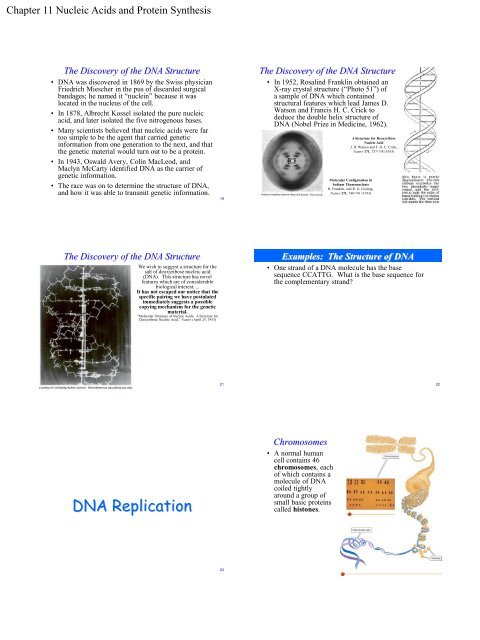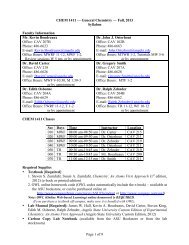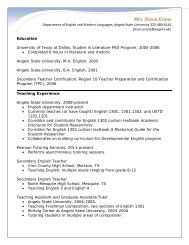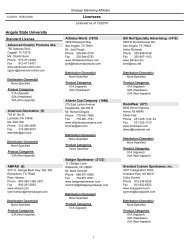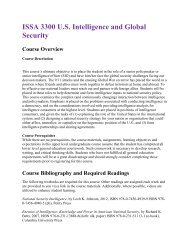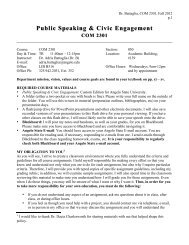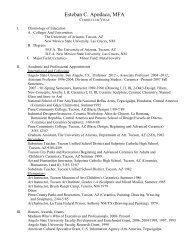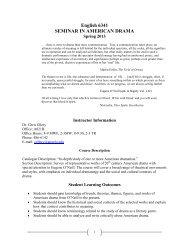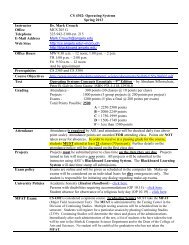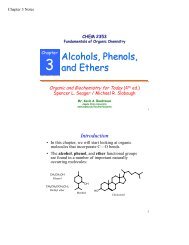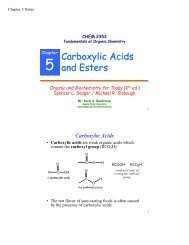Download - Angelo State University
Download - Angelo State University
Download - Angelo State University
Create successful ePaper yourself
Turn your PDF publications into a flip-book with our unique Google optimized e-Paper software.
Chapter 11 Nucleic Acids and Protein Synthesis<br />
The Discovery of the DNA Structure<br />
• DNA was discovered in 1869 by the Swiss physician<br />
Friedrich Miescher in the pus of discarded surgical<br />
bandages; he named it ―nuclein‖ because it was<br />
located in the nucleus of the cell.<br />
• In 1878, Albrecht Kossel isolated the pure nucleic<br />
acid, and later isolated the five nitrogenous bases.<br />
• Many scientists believed that nucleic acids were far<br />
too simple to be the agent that carried genetic<br />
information from one generation to the next, and that<br />
the genetic material would turn out to be a protein.<br />
• In 1943, Oswald Avery, Colin MacLeod, and<br />
Maclyn McCarty identified DNA as the carrier of<br />
genetic information.<br />
• The race was on to determine the structure of DNA,<br />
and how it was able to transmit genetic information.<br />
The Discovery of the DNA Structure<br />
We wish to suggest a structure for the<br />
salt of deoxyribose nucleic acid<br />
(DNA). This structure has novel<br />
features which are of considerable<br />
biological interest. ...<br />
It has not escaped our notice that the<br />
specific pairing we have postulated<br />
immediately suggests a possible<br />
copying mechanism for the genetic<br />
material.<br />
―Molecular Structure of Nucleic Acids: A Structure for<br />
Deoxyribose Nucleic Acid,‖ Nature (April 25, 1953)<br />
DNA Replication<br />
19<br />
21<br />
23<br />
The Discovery of the DNA Structure<br />
• In 1952, Rosalind Franklin obtained an<br />
X-ray crystal structure (―Photo 51‖) of<br />
a sample of DNA which contained<br />
structural features which lead James D.<br />
Watson and Francis H. C. Crick to<br />
deduce the double helix structure of<br />
DNA (Nobel Prize in Medicine, 1962).<br />
A Structure for Deoxyribose<br />
Nucleic Acid<br />
J. D. Watson and F. H. C. Crick,<br />
Nature 171, 737-738 (1953)<br />
Molecular Configuration in<br />
Sodium Thymonucleate<br />
R. Franklin, and R. G. Gosling,<br />
Nature 171, 740-741 (1953)<br />
Examples: The Structure of DNA<br />
• One strand of a DNA molecule has the base<br />
sequence CCATTG. What is the base sequence for<br />
the complementary strand?<br />
Chromosomes<br />
• A normal human<br />
cell contains 46<br />
chromosomes, each<br />
of which contains a<br />
molecule of DNA<br />
coiled tightly<br />
around a group of<br />
small basic proteins<br />
called histones.<br />
20<br />
22<br />
24


